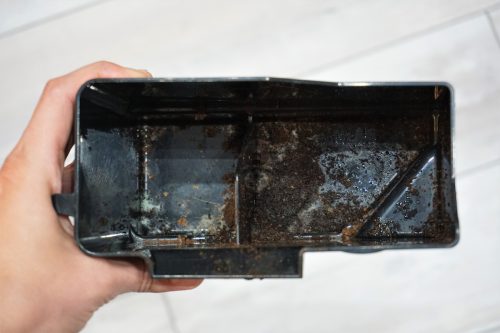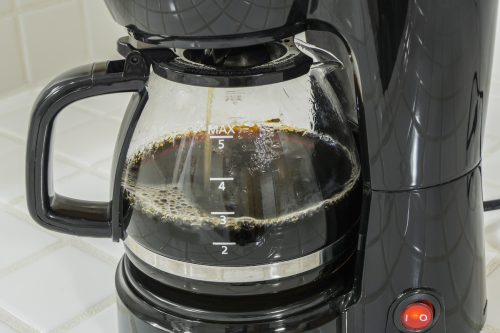What Happens If You Never Clean Your Coffee Maker, Experts Say

As long as your coffee maker brews you that cup of joe every morning, there’s not much to think about, right? Sure, maybe you rinse out the basket once in a while or even throw the carafe in the dishwasher here and there. But what about what’s going on inside? Do you really need to wash it? To get the answer, we consulted experts on what happens if you never clean your coffee maker. Keep reading for their advice—and be prepared to have your work cut out for you before you’ll want to drink that next cup of coffee.
READ THIS NEXT: What Happens When You Don’t Wash Your Sheets Every Week, Doctors Say.
Your coffee maker could be affecting your health.

The biggest concern around cleaning one’s coffee maker is whether or not it’s harboring bacteria and mold, since these like to grow in dark, damp places.
“This is especially true if you’re using a machine with a water tank that’s not regularly emptied and cleaned,” says Paulo Filho, owner and cleaner at Celestial Cleaning Service. “Bacteria such as E. coli and Staphylococcus aureus can flourish in these conditions, leading to serious illness.”
But it’s not just bacteria you need to worry about. “Wet coffee grounds left behind from not regularly cleaning your machine are the perfect breeding place for mold and may even attract cockroaches,” adds Leanne Stapf, COO of The Cleaning Authority.
It could have limescale that’s affecting the coffee’s taste.

The most common reason experts say you’ll want to clean your coffee maker is to get rid of built-up limescale, “a hard, chalky deposit that can form in your coffee machine when hard water is used to make coffee,” explains Andrii Gurskyi, co-founder of cleaning services HomeClean and Mr. Glazier
Having these mineral deposits can affect the taste of your coffee. “Additionally, oil residue found in coffee beans builds up very quickly, which will leave behind an unpleasant odor that ruins the taste of your ground coffee,” says Stapf.
Limescale buildup can also affect the machine itself, causing decreased water flow and clogs, which can cause permanent damage, says Gurskyi.
For more cleaning advice delivered straight to your inbox, sign up for our daily newsletter.
Here’s how to know when it’s time for a cleaning.

As mentioned, if you notice that your coffee tastes funny, it could be time for a cleaning. Likewise, brewing taking longer than normal or your machine getting stuck, are also good indicators. Many coffee makers also have a “clean” light that will activate when it’s time.
If everything seems fine, you’ll still want to clean your coffee maker regularly, since mold, bacteria, and limescale are often lurking. “You should routinely give your coffee machine a light clean every week to help this appliance last longer,” recommends Stapf. To further extend its lifespan, you should decalcify (remove mineral buildup) your coffee maker every one to two months.
And here’s how to clean it.

When it comes to decalcifying (or de-scaling, as people commonly say) your coffee maker, white vinegar is your best bet.
For an auto drip coffee maker, Stapf recommends filling your coffee maker with half water and half vinegar and running through half of a normal drip cycle, pausing to soak for 30 minutes. Next, she says to rinse the reservoir with soap and hot water, then run a cycle with just water “to ensure all the vinegar is filtered through and eliminated from your system.” Now add a small scoop of baking soda and run one more cycle. “If it fizzles, you know there is still lingering vinegar,” she says. Finally, wash out the inside of the reservoir one last time and wipe down the exterior with a cloth.
For a Keurig coffee maker, Stapf says the process is very similar; you’ll just have to catch the water in mugs until all the vinegar has run through.
If you use a French Press or a manual coffee maker, you’ll need to disassemble all the parts. Separate the lid, the plunger, the filter screens, and the disks, and rinse off any leftover grounds, Stapf instructs. Then fill up the sink with warm water and vinegar and soak your disassembled parts. Scrub with a soapy sponge, and thoroughly rinse and let dry.
Some coffee makers might also have a self-cleaning feature, “which can be activated by following the manufacturer’s instructions,” Gurskyi notes.